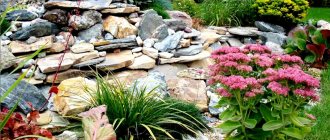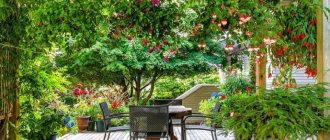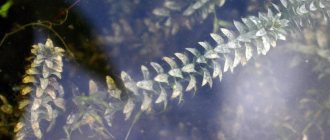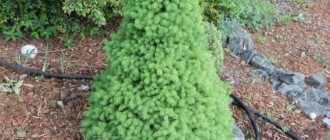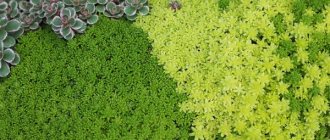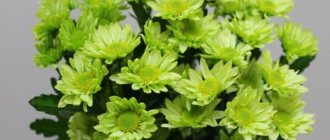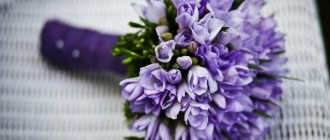A well-designed rocky flower bed, imitating a rocky mountain slope in the Alps, will become the hallmark of your site. But in order for it to look aesthetically pleasing and elegant all season long, you need to choose the right rock plants for it.
Plants for rock gardens are becoming increasingly popular, since such a flower arrangement is one of the central decorative elements of a modern garden. The rock garden is arranged in places open to the sun, in the most presentable places on the site, where it will be admired throughout the summer season.
Read about how to arrange an alpine slide in the garden in our material.
- DIY Alpine slide
The picturesque landscape of the Alpine mountains inspired gardeners to create alpine slides, which traditionally consist of a combination of stones and mountain plants
Catchment (Columbine)
This exquisite herbaceous perennial exhibits unique blooms with long, narrow petals. The flowering plant comes in a variety of colors and attracts butterflies. Once established, this slender wildflower is drought tolerant. Cut it back in the fall and see if volunteer shoots appear in the spring.
Crassulaceae
Your rock garden wouldn't be complete without succulents, and Crassula plants are one of the most popular options. This succulent grows best in full sun to partial shade, and while it is suitable as a ground cover, it does require adequate drainage. The cuttings can be easily replanted throughout the garden.
Caring for a DIY rock garden
Caring for a rocky garden depends on the species composition of the plants planted in it. But there are also general recommendations:
- Plants should be watered as needed.
- Weed the rockery regularly.
- Add soil.
- Prune plants.
- Remove faded flower stalks.
- Remove and then replace diseased and dead plants.
Countless options are created by placing plants in a rock garden . The main thing is that the chosen option looks beautiful and, naturally, does not abound in unnecessary diversity and is a favorite vacation spot.
Beautiful rock garden options
- Author: Maria Sukhorukikh
Rate this article:
- 5
- 4
- 3
- 2
- 1
(3 votes, average: 5 out of 5)
Share with your friends!
Geranium (Cranesbill Geranium)
Geraniums are a favorite among gardeners because they require little care. Placement in full sun results in highly productive flowering, but geraniums can tolerate partial shade. The purple flowers stand out against the green textured foliage of the geranium. The plant thrives with little care: cut the plant 10cm above the ground after it has finished blooming to encourage a second bloom; Divide the plant every three to five years when the center of the plant dies. In turn, this plant will reward you with new flowers year after year.
Large mammals
Animals of alpine meadows are represented by chamois, aurochs, mountain goats and other ungulates. Most often in the highlands you can find chamois. She jumps over huge chasms and climbs steep cliffs to the top. The chamois seems to hover over the peaks; it easily finds even the smallest crack to cling to, and stays on a barely noticeable cornice. In winter, animals descend from the mountains, driven away by cold and hunger. Chamois winter in coniferous forests, taking the place of roe deer and red deer, which in the cold season descend even lower into river valleys and deciduous forests. The hardest thing for ungulates is wintering, because hunger, inclement weather, and avalanches constantly reduce their numbers.
Blue Fescue Grass
Ornamental grass adds volume and lushness to the rock garden, and blue fescue is an ideal choice. Its bluish-green color stands out among perennial plants or provides a decorative sheen among rocks and boulders. It prefers full sun but can tolerate some shade and does best in medium to low moisture soil and can also tolerate light frost.
Tomentosum (Cerastium tomentosum)
If you're looking to add a little charm to your rock garden, the plant is a great choice for placement among rock structures, and since it self-seeds, you never know where the plant will sprout next season. It is a low-maintenance, perennial, ground cover plant boasting silver-green foliage and bright white flowers in spring and summer. Drought tolerant, requires sun and good drainage for optimal growth.
Features of the mixborder device
Mixborders are very popular among gardeners today. The arrangement of such a shrub requires some skill, since in one flower bed it is necessary to combine flowers that at first glance seem incompatible. Just like when choosing plants for an alpine hill, the names and photos of flowers for a mixborder can be viewed in different sources.
A mixborder will look interesting if the plants bloom alternately throughout the entire period. Therefore, you first need to develop a planting plan and strictly follow it.
Features of mixborder
Lavender
Want to add some scent to your rock garden? With its heavenly scent and storybook blooms, lavender is a garden classic. Suitable for hot weather and poor soil, ideal for rocky terrain. Grows well on its own or in combination with other shrubs and ornamental grasses. Lavender requires full sun and well-drained soil. Lavender can be harvested to make tea, making it as welcome in the home as it is in the garden.
Rock garden plants blooming in spring
What flowers in a spectacular rocky garden will delight you with the brightness of their colors in early spring.
Adonis spring, or adonis
Adonis, named after the beautiful ancient Greek god, is considered a symbol of the blossoming of spring. Large bright yellow flowers (their diameter reaches 6 cm) open their “luminous” petals towards the spring sun already in April. In the wild it grows in spacious meadows, so it loves well-lit areas.
Prefers moist and loose soil, looks great along paths, on the eastern and western sides of alpine hills. A pleasant feature of the plant is that since it is poisonous, it is not afraid of diseases and pests, as well as returning spring frosts. The only pity is that these mini “suns” bloom only in the 3rd or 4th year.
Anemone or anemone
Anemos means “wind” in Greek, hence the second name of the flower. Despite its external fragility, it is quite durable - it can withstand even the harshest weather conditions. About 150 species of anemone have been described, but no more than a dozen varieties and hybrids have decorative properties.
Anemones look great in rock gardens; piles of stones are a familiar environment for them. On the lower tiers of rocky hills there are “stone roses”), garden geraniums.
Erica is rosy
This is a low (up to 60 cm) evergreen shrub from the Ericaceae family with bright green needle-like leaves. It resembles a small Christmas tree with fluffy branches, strewn with small pink or red bell flowers. Flowering is long, the first flowers bloom in April-May, and the last ones fade by the end of August.
Like heather, with which Erica is often confused, it grows, creating a beautiful carpet. Prefers acidic soils, but also thrives in neutral ones. Frost resistance is good, but in severe frost it is advisable to cover it. Goes well with low-growing conifers, thyme, and ornamental grasses.
Felt cleaver
A very winter-hardy and unpretentious plant with characteristic silver-gray pubescent leaves. It blooms in May - early June, grows beautifully, forming a lush cloud of snow-white flowers. It loves places illuminated by the sun, and it grows even on poor rocky soil, but in extreme heat it still needs to be watered.
Due to its small growth (no higher than 30 cm), it goes well with shrubs (barberry, cotoneaster) and perennials (bells, phlox, heuchera). Looks impressive among large stones.
Purple Fountain Grass
Consider planting purple pinnately as a centerpiece in your rocky garden. This ornamental grass grows from 100 to 150 cm in height and grows well in full sun and medium to low moisture soil. Purple pinnate bristle, which does not require special care, will delight you for many years to come.
Tips and tricks for properly arranging a flower garden
In order to create a magnificent masterpiece on your site that will attract the attention of passers-by and guests, you should follow some recommendations. Advice from experts will help everyone improve their plot with their own hands.
- When arranging an alpine hill, you must choose only untreated stones. Only in this case can the natural mountainous terrain be depicted as accurately as possible.
- As for the size of the stones, you need to use different fractions, which will be arranged in a certain composition.
- Looking through photos and names of plants for an alpine slide, you should choose the most suitable options.
- To make the rock garden look attractive in winter, it is worth choosing a number of evergreen plants. Even under the cover of snow, such a garden element will be a kind of decoration.
- For a rock garden, you should not choose a large number of deciduous plants. In autumn, it will be quite difficult to remove leaves between the stones.
- For mixborders, it is best to use perennial flowering plants, which will be much easier to care for.
- It is worth planting short plants in the foreground of the mixborder, and taller ones further away.
- Only proper and timely care guarantees the attractive appearance of the mixborder.
Rock garden in the garden
The decoration of any garden is a huge number of flowers. Their disorderly and chaotic arrangement will not cause any delight in anyone. In order for flowers to become a true decoration of the garden, it is necessary to group them into a specific composition. Today the rock garden is especially popular.
This is a landscape decorative element that anyone can create. It is important to follow some recommendations from specialists who will help you complete all the work correctly and get a high-quality result. Another great decoration for any garden plot will be a mixborder. Despite the difficulty in care, its appearance always causes delight. Externally, the mixborder changes as new plants begin to bloom, completely changing the landscape.
Sedum Autumn Joy
The deep pink flowers of this stunning perennial plant will bring a romantic ambience and softness to your garden. Due to its height and density, sedum is a suitable replacement for shrubs. This bee- and butterfly-friendly perennial plant requires full sun, average humidity and well-drained soil. Sedum grows slowly and blooms from late summer to mid-autumn. Repot the plant every three to four years to maintain its compact appearance.
Follow us on Pinterest for more interesting articles.
Useful short videos from Make-Self.net
